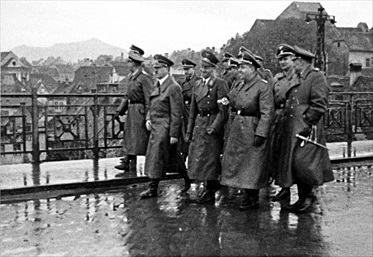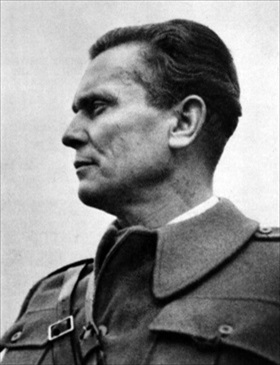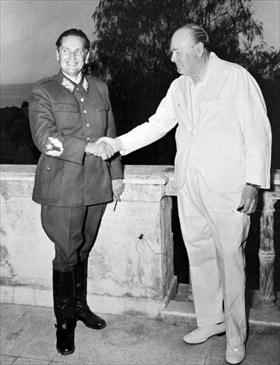YUGOSLAVIA JOINS AXIS PACT
Vienna, Austria · March 25, 1941
On this date in 1941 in Vienna, the government of Yugoslav regent Prince Paul signed a protocol of adherence to the Berlin-Rome-Tokyo Tripartite Pact, thereby setting the stage for a complex guerrilla war against Germans, Italians, and their Yugoslav allies, and within the Yugoslav resistance forces themselves. Not two days after aligning Yugoslavia with the Axis, the Yugoslav Army overthrew Prince Paul and proclaimed seventeen-year-old Peter II as king. A new cabinet announced a policy of neutrality.
In Berlin Adolf Hitler was furious and lost little time raining bombs on Belgrade, the Yugoslav capital, killing 17,000 civilians in a series of air raids—the largest number of dead in a single day since the European conflict began in September 1939. Outmatched in the air and on the ground, the Yugoslav high command surrendered on April 17. Not until three and a half years later, on September 6, after smashing and occupying Romania and declaring war on neighboring Bulgaria, did the Allies in the form of the Red Army set foot on Yugoslav soil, pushing their way to the Dalmatian coast and linking up with Yugoslav Partisans, who for months had tied down a considerable number of German troops.
To the south of Yugoslavia, British airborne forces descended on Greece (September 24, 1944) and advanced on Athens, liberating the capital on October 13. On October 19, German forces, holed up in Belgrade, Yugoslavia, for half a week, fled the ruined capital, which was occupied by Soviet troops and Josip Tito’s Yugoslav Army on October 20.
That same week, October 9–19, 1944, British Prime Minister Winston Churchill was in Moscow for discussions with Soviet leader Joseph Stalin. The two men adopted the Percentages Agreement, whereby the two Allies divided the Balkan region into spheres of influence. Under terms of the agreement, the Soviets would predominate in Romania, Bulgaria, and Hungary—Axis countries where the Red Army had been or would soon be, while Great Britain would assume power in Greece. Both countries would share influence in Yugoslavia. President Franklin D. Roosevelt, upon learning of the agreements reached by Churchill and Stalin, announced that his administration would not be bound by the terms.
Yugoslavia in World War II
 |  |
Left: King Peter II of Yugoslavia wearing the uniform of the Royal Air Force, January 1944. On March 27, 1941, Peter, then 17, was proclaimed of age and participated in a British-supported coup d’état opposing the Tripartite Pact. Peter (reign: 1934–1945) was forced to leave the country with the Yugoslav government following the Axis invasion by German, Italian, and Hungarian armies.
![]()
Right: Hitler in the company of his press secretary and the chief of his chancellery crossing the Old Bridge (Stari most) in Marburg an der Drau (Maribor), occupied Yugoslavia (in today’s Northeastern Slovenia), 1941.
 |  |
Left: Partisan supreme commander Marshal Josip Broz Tito, 1942. Tito’s formidable communist guerrilla force, concealed in rural villages, the countryside, and mountain strongholds, was a constant thorn in the side of the Wehrmacht (German armed forces), prompting numerous anti-Partisan operations and much bloodshed.
![]()
Right: Tito and British Prime Minister Winston Churchill, keeping his distance, pose for the camera in Naples, Italy, 1944. Churchill called it one of his biggest wartime blunders—shifting British and U.S. support from Yugoslavia’s Draža Mihailovic and his royalist resistance movement to Tito and his communist Partisans.
Joining Axis Pact Unleashes Series of Yugoslav Tragedies
![]()

 History buffs, there is good news! The Daily Chronicles of World War II is now available as an ebook for $4.99 on Amazon.com. Containing a year’s worth of dated entries from this website, the ebook brings the story of this tumultuous era to life in a compelling, authoritative, and succinct manner. Featuring inventive navigation aids, the ebook enables readers to instantly move forward or backward by month and date to different dated entries. Simple and elegant! Click
History buffs, there is good news! The Daily Chronicles of World War II is now available as an ebook for $4.99 on Amazon.com. Containing a year’s worth of dated entries from this website, the ebook brings the story of this tumultuous era to life in a compelling, authoritative, and succinct manner. Featuring inventive navigation aids, the ebook enables readers to instantly move forward or backward by month and date to different dated entries. Simple and elegant! Click 











